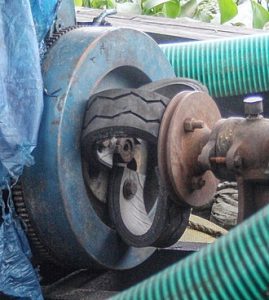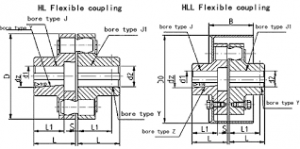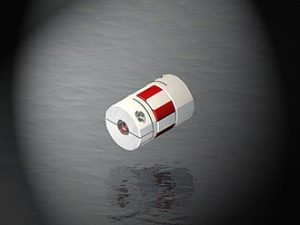Coupling:
Coupling is the device that is used for the connection of shafts to transmit power and torque.
Coupling is the connection of shaft units that are manufactured separately.
Coupling failure occurs due to key and bolts. So it can be covered by flanges to avoid failure.
The shafts may have all-direction axes.
Couplings are used for variable-type applications.
Examples:
Motor and generator
Motor and pump
Flexible Couplings Definition:
Flexible couplings are the coupling device used for the flexible connection.
It is the type of coupling used to join shafts having misalignment in lateral or angular directions.
It has flexible connection allowing the misalignments.
The elements used have the capacity to absorb the shock loads and the vibrations.

Flexible Coupling types:
Bushed pin type Coupling
Universal Coupling
Oldham Coupling
Flexible coupling applications:
Machines,
servomechanisms,
instrumentation,
light machinery,
steel industry,
the petrochemical industry,
utilities, off-road vehicles,
and heavy machinery, etc.
other flexible coupling applications;
Flexible coupling categories:
Elastomeric couplings –
Elastomeric coupling has elastic properties.
It is the part of the flexible coupling which can attain their flexibility from the material’s tension and compression ability.
Material Example: Rubber, plastic, etc.
Advantages:
Material uses: Rubber or plastic leading to low in cost and allows temperature rise.
Resistant to fatigue failure.
It provides longer life at a minimal cost.
Regular maintenance is not required as it doesn’t use any lubrication.
No need to use lubrication, so regular maintenance is not required.
Mechanically flexible couplings –
Mechanically flexible couplings are part of the flexible coupling, and it gets its flexibility from the loose-fitting parts and the rolling and sliding parts.
It requires regular lubrication.
Example: Nylon gear coupling
Gear coupling:
A gear coupling
is the application part of a flexible coupling
It is the type of coupling the shafts with gears mounted on the hubs.
Sleeves (hollow cylinders) have internal gear teeth.

Regular lubrication is required.
lubrication used: grease, oil
Advantages :
It provides good torque characteristics.
Metallic membrane couplings –
Metallic membrane coupling is the application of flexible coupling.
It gets its flexibility from the flexing of the metallic discs (thin).
Miscellaneous couplings –
Miscellaneous coupling is part of the flexible coupling.
This type of coupling gets its flexibility from the combinations of the mechanisms like spring couplings.
Flexible coupling functions:
It Transmits power.
It Transmits torque.
The selection of the flexible coupling
depends on the max rotational speed.
Power loss is due to the friction heat from the sliding and rolling at high speeds.
Loss of efficiency is due to frictional losses.
The flexible coupling has the advantage that it is the coupling that can give efficiency more than 99%.
Flexible coupling drawing:


Advantages of flexible coupling:
It allows small misalignments.
It absorbs shock loads and vibrations.
It can transmit a high amount of torques.
Simple in construction
Disadvantages of flexible coupling:
It has a high cost due to additional parts.
Require more space.
Bush pin type flexible coupling:
It is the type of coupling used to connect shafts with smaller misalignments.
Transmits the torque from the high tensile material to the input shaft.
Material used: Rubber and leather(bush)
The material gives the flexibility to the coupling.
The flanges are keyed to the shafts.
Example: Electric motors.
The permissible bearing pressure value= 0.5 N/mm2
Flexible grooved coupling:
The grooved coupling having the flexible connection is Flexible grooved coupling.
It allows some misalignment in the shaft connection.
Thomas flexible disc coupling:
Some couplings don’t require regular maintenance. It can work properly on its own.
The coupling is all flexible metal parts coupling. The coupling is known as Thomas flexible disc coupling.
Advantages of flexible coupling over rigid coupling:
Flexible coupling can be used with low levels of torque transmission
and small misalignments.
It allows slight misalignment and still can transmit the same amount of torque as rigid coupling.
Difference between rigid and flexible grooved coupling:
As you know that Flexible coupling creates flexible connections between equipment and the components used to assemble the coupling fixed with some amount of loose, that why some amount of misalignment it can absorb. But metallic flexible type has greater torque capability than other flexible couplings, and some torque will be lost during complete operation of equipment.
Flexible shaft coupling:
Flexible shaft coupling is the flexible connection of the coupling shafts
It prevents coupling failure.
It reduces noise, vibrations and protects coupling components.
Flexible spacer type coupling:
It is the type of coupling which has an extra length shaft installed in the shafts.
It provides space to remove the mechanical seal during maintenance.
Flexible coupling alignment tolerance:
Up to 400 mils.
Flexible coupling design:
The flexible coupling is designed to calculate the torque and power transmission, considering the misalignment in any direction.
Due to less misalignment, There is less movement in the parts.
This leading to less axial and bending stresses development in the shafts.
Torque=P/rotational speed,
If the speed of the shaft increases, power increases, and torque decrease. There is the possibility of a loss of torque.
Flexible Coupling alignment:
Limitations
Parallel misalignment=0.005in,for smaller couplings,
Parallel misalignment=0.030in,for larger couplings,
angular misalignment=±3°
Misalignment types:
Parallel offset: This type of offset occurs in the flexible couplings shaft connection where both the shaft axes are parallel to each other and not in the same line.
Angular offset: This type of misalignment occurs in the flexible coupling shafts where the axes of the shafts meet at the center points of the coupling.
Combined parallel and angular offset: This type of misalignment is the flexible coupling offset of the shafts where the axes of the shafts do not intersect and are not parallel to each other.
Flexible coupling material:
Brass.
Aluminum.
Cast Iron.
Stainless Steel.
Carbon Steel.
Rubber etc.
Flexible coupling at high temperature:
At the high temperature, the couplings will transmit thrust between the machines.
A the temperature increases, the couplings will be more flexible and it will give more flexible connection.
At increasing temperatures, The coupling losses it’s torsional stiffness, increasing more pressure.
Flexible chain coupling:
Roller chain coupling, in which sprockets are attached at adjacent ends of the two abutting shafts, then wrapped together by a common roller chain segment that spans both sprockets. Clearance between the chain and the sprockets allows up to degrees of angular shaft-centerline misalignment and up to about 0.010 inches parallel shaft-centerline misalignment. Roller chain couplings are low-cost, high-torque devices but may be noisy. Wear or fretting wear is a potential failure mode.
Flexible coupling encoder:
It is a device used to provide maximum mechanical protection.
It is the protected type flexible coupling device which protects the coupling.
Flexible disc type coupling:
Flexible disk couplings are the disc type coupling that allows smaller angular and parallel misalignment.
Misalignment of about one degree of angular misalignment and an inch of parallel shaft misalignment can be observed.
Flexible grid coupling:
A grid coupling is a system consisting of two shafts, a grid spring(metallic), and a split cover.
This type of coupling is the coupling device that transmits torque between the coupling shafts using a metallic grid spring.
Advantages:
High torque density.
The grid coupling spring elements have the ability to absorb shock loads and peak loads.
It also has the capacity to dampening the vibrations.
flexible type of coupling tend to have ability to allow the misalignment.
Flexible coupling Problems and solutions:
1)The motor power is 50 KW, and the speed given in rpm is 300rpm. The bearing pressure on bush is equal to 0.5MPa. Allowable shear stress is 25MPa, and the bearing stress is 50MPa. The shear yield strength given is 60MPa. Given data: shaft dia. = 50mm,pins diameter(PCD)=140mm.
Determine the dimensions of the rubber bush for flexible coupling.
Solution:
- Torque transmitted,


T=159N-m. - shaft diameter

![]()
d=23.8mm
Let, d=25mm,![]()
n= no. of pins,![]()
![]()
n=4,
dneck= 8mm shear stress,
![]()
![]()
yield stress of the pin material.
d=Dpin+2*t(sleeve)
d=20mm
t=6mm
Bush length,
T= 159Nm, p = 0.5MPa,
dbush =0.02m and dc = 0.14m ,L = 56.78 mm.
2)Design a bushed-pin type flexible coupling shaft transmitting 50 Kw at 1000rpm. The bearing pressure in the rubber bush is 0.5MPa and allowable shear stress in the pins is 25Mpa.
The Diameter of shaft is 60 mm.
Given:
P = 50KW;
N = 1000 rpm,
d = 50 mm,
Solution:
T = (p)/ (2πN/60) = (50×1000×60)/ (2π×1000) = 477.46 N-mm.


![]()
![]()
Design of hub:
D=2d=260=120mm, Length=1.5d=1.560=90mm,
![Rendered by QuickLaTeX.com T=\\frac{\\pi }{16}\\tau c[\\frac{D^{4}-d^{4}}{D}]](https://lambdageeks.com/wp-content/ql-cache/quicklatex.com-30ba917916b5eb28a3d87a31000b312d_l3.png)
![Rendered by QuickLaTeX.com 477.46*10^{3}=\\frac{\\pi }{16}\\tau c*[\\frac{120^{4}-60^{4}}{120}]](https://lambdageeks.com/wp-content/ql-cache/quicklatex.com-3ee45829926cbb8c0dd114721d3ddfeb_l3.png)
![]()
Design of key:
W=20mm,
t=10mm,
L=1.5d=1.560=90mm,


![]()
Key in crushing:


![]()
Design of flange:
t=0.5d=0.560=30mm,


![]()
Design of bolt:![]()
![]()
d1=12.24mm.
n=6,
Assume t= 5 mm, (rubber bush)
d2=25+22+25
d2=39mm,
D1=2d+d2+2n D1=171mm, D2=4d=460=240mm, W=Pbd2l, W=0.539l,
![]()
![]()
l=44.7mm,
W=871.65N.
Due to pure torsion,
![]()
![]()
![]()
Frequently Asked questions:
What are the three types of flexible compression couplings:
Jaw type coupling
Donut type coupling
Pin and bushing type coupling.
Flexible coupling vs. solid coupling:
solid coupling is rigid coupling. a Rigid coupling is the coupling device that is rigid in connection, whereas flexible coupling is the coupling device that is flexible in connection.
Flexible coupling elements have the ability to absorb vibrations and shock loads, whereas rigid coupling is free of vibrations and shock loads.
Shielded coupling vs. flexible coupling:
Shielded coupling is a unique type of coupling.
Shielded coupling is encased in a metal case.
It is used for underground applications.
Flexible coupling types- According to their uses:
General-purpose Flexible coupling
Gear type
Chain type
Grid type coupling
special purpose Flexible coupling
mechanically flexible type, etc.
For more articles, click here.
Read more about Rigid And Flange Rigid Coupling.

I am Sulochana. I am a Mechanical Design Engineer—M.tech in design Engineering, B.tech in Mechanical Engineering. I have worked as an intern at Hindustan Aeronautics limited in the design of the armament department. I have experience working in R&D and design. I am skilled in CAD/CAM/CAE: CATIA | CREO | ANSYS Apdl | ANSYS Workbench | HYPER MESH | Nastran Patran as well as in Programming languages Python, MATLAB and SQL.
I have expertise on Finite Element Analysis, Design for Manufacturing and Assembly(DFMEA), Optimization, Advanced Vibrations, Mechanics of Composite Materials, Computer-Aided Design.
I am passionate about work and a keen learner. My purpose in life is to get a life of purpose, and I believe in hard work. I am here to excel in the field of Engineering by working in a challenging, enjoyable & professionally bright environment where I can fully utilize my technical and logical skills, constantly upgrade myself & benchmark against the best.
Looking forward to connect you through LinkedIn –